课程思政案例《InterpretingII(口译二)》
- 格式:docx
- 大小:37.90 KB
- 文档页数:11
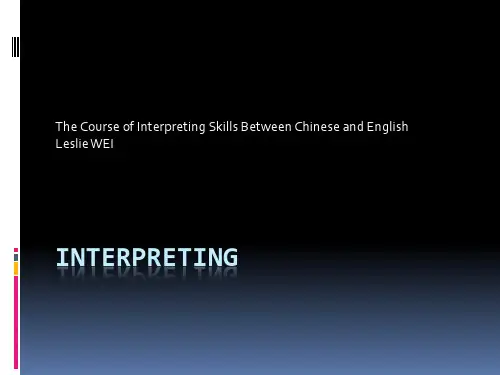
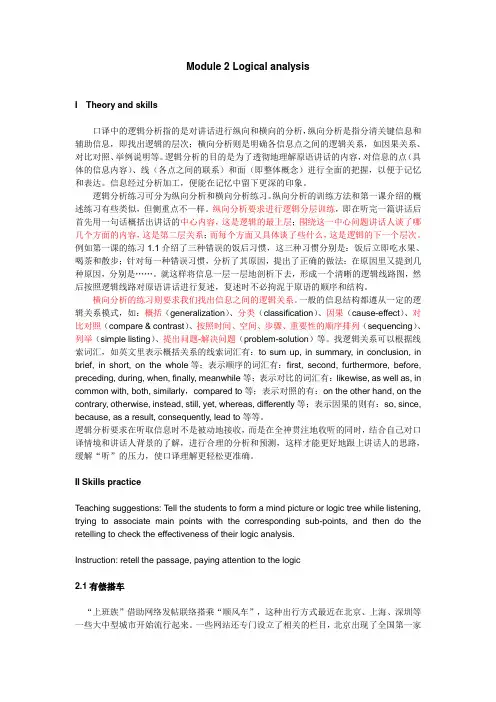
Module 2 Logical analysisI Theory and skills口译中的逻辑分析指的是对讲话进行纵向和横向的分析,纵向分析是指分清关键信息和辅助信息,即找出逻辑的层次;横向分析则是明确各信息点之间的逻辑关系,如因果关系、对比对照、举例说明等。
逻辑分析的目的是为了透彻地理解原语讲话的内容,对信息的点(具体的信息内容)、线(各点之间的联系)和面(即整体概念)进行全面的把握,以便于记忆和表达。
信息经过分析加工,便能在记忆中留下更深的印象。
逻辑分析练习可分为纵向分析和横向分析练习。
纵向分析的训练方法和第一课介绍的概述练习有些类似,但侧重点不一样。
纵向分析要求进行逻辑分层训练,即在听完一篇讲话后首先用一句话概括出讲话的中心内容,这是逻辑的最上层;围绕这一中心问题讲话人谈了哪几个方面的内容,这是第二层关系;而每个方面又具体谈了些什么,这是逻辑的下一个层次。
例如第一课的练习1.1介绍了三种错误的饭后习惯,这三种习惯分别是:饭后立即吃水果、喝茶和散步;针对每一种错误习惯,分析了其原因,提出了正确的做法;在原因里又提到几种原因,分别是……。
就这样将信息一层一层地剖析下去,形成一个清晰的逻辑线路图,然后按照逻辑线路对原语讲话进行复述,复述时不必拘泥于原语的顺序和结构。
横向分析的练习则要求我们找出信息之间的逻辑关系。
一般的信息结构都遵从一定的逻辑关系模式,如:概括(generalization)、分类(classification)、因果(cause-effect)、对比对照(compare & contrast)、按照时间、空间、步骤、重要性的顺序排列(sequencing)、列举(simple listing)、提出问题-解决问题(problem-solution)等。
找逻辑关系可以根据线索词汇,如英文里表示概括关系的线索词汇有:to sum up, in summary, in conclusion, in brief, in short, on the whole等;表示顺序的词汇有:first, second, furthermore, before, preceding, during, when, finally, meanwhile等;表示对比的词汇有:likewise, as well as, in common with, both, similarly,compared to等;表示对照的有:on the other hand, on the contrary, otherwise, instead, still, yet, whereas, differently等;表示因果的则有:so, since, because, as a result, consequently, lead to等等。
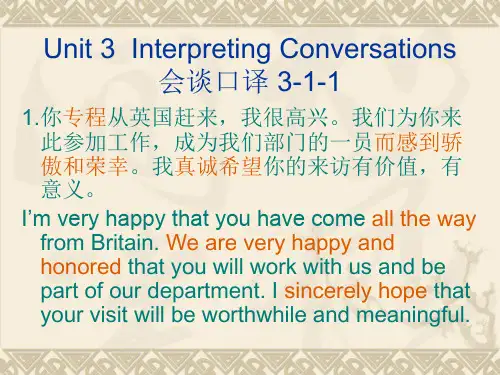
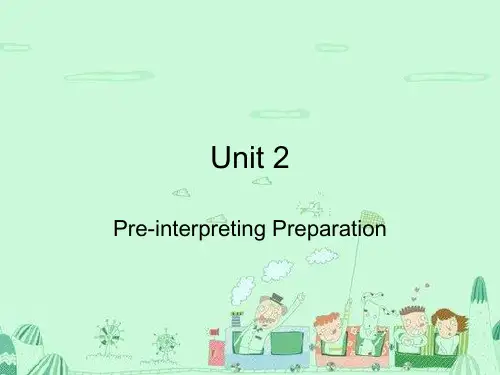
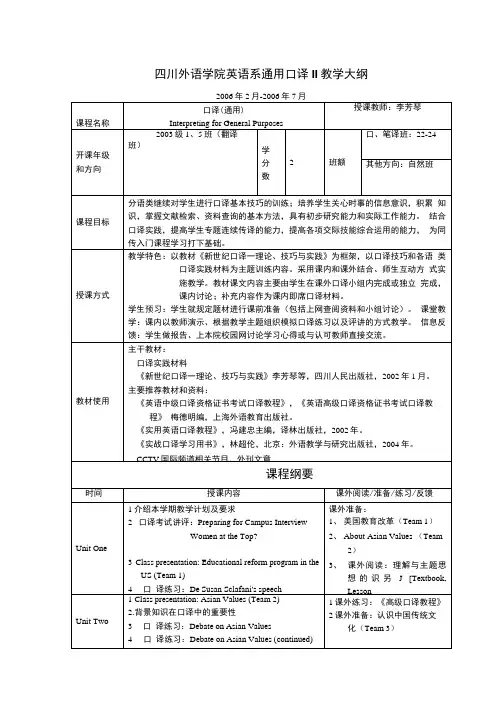
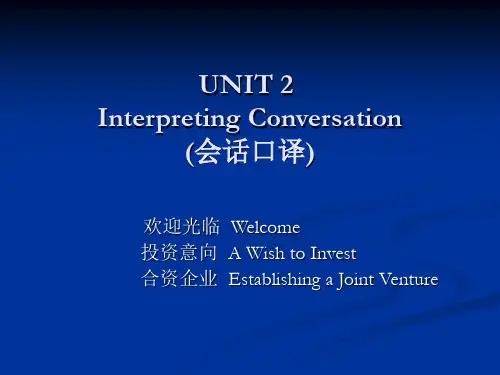
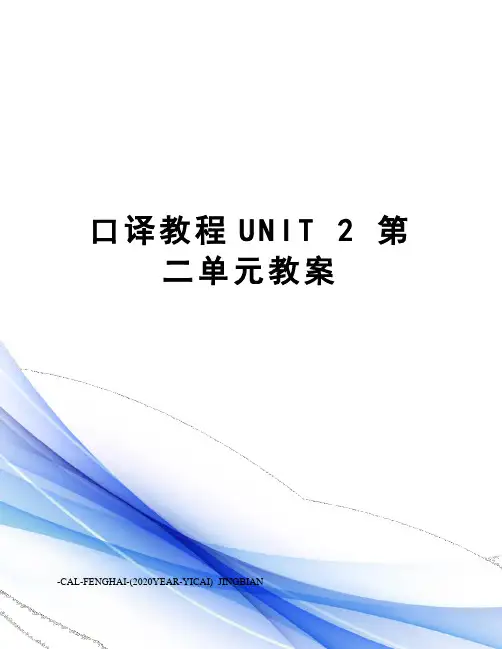
口译教程U N I T2第二单元教案-CAL-FENGHAI-(2020YEAR-YICAI)_JINGBIANUNIT 2 第二单元教案来源:口译-学院精品课程作者:Jay J YangMemoria Technica (II)口译记忆(二)Unit Objective (单元目标)After reading this unit you should☆ understand the process of memorization.☆ master the “Memoria Technica”.Warm-up (准备)1. Two students are requested to sit at the Interpreting Desk or Booth, acting as interpretors of the class. Their performance is evaluated and graded by instructor.2.One or Two students are asked to present a piece of news or a weather forecast of the week.Theory of Interpretation II (口译理论二)口译记忆过程:源语信息编码+信息存储+信息提取+译语信息解码口译记忆方法:源语复述;总结概括;逻辑整理;影子练习。
Memoria Technica (记忆法)Listen to the following sentences, and try to catch the key words and details, then repeat as accurately as possible:A. Two sentences repeating::Sentences from Textbook Unit One as a part of review:1.20 years ago, almost to the day, President Ronald Reagan spoke at thisuniversity and expressed the essence of economic and political freedom.pared t o President Nixon’s, or even President reagon’s day, many Chinesecitizens are now freer to make their own ways of life ---- to choose carers, toaquire property, and to travel.3.China’s economic success has also come about through far greater integrationinto the world economy. In the last decades, your country has emerged asmajor exporter of all kinds of manufactured goods, from heavy machinery,to computers, to toys.Sentences prepared by instructor:4.The European colonists first sailed west to America and founded their firstsettlements on the Atlantic Coast.5.The United States became the World’s first modern democracy after its breakwith Great Britain in 1776 and the adoption of a constitution in 1789.6.Congress is the legislative branch of the Union. It consists of two houses: theHouse of representatives and the Senate. according the constitution, the twohouses are of equal importance and check each other.7.The US has the most technologically powerful, diverse, advanced and largesteconomy in the world, with a per capita GDP of $33,900.8.Lishui College is co-administrated by the Provincial Education Commission andthe city government.9.China’s institutions of higher learning are classified as comprehensiveuniversities, science and engineering universities and specialized institutes.10.At present, Chinese educational system can be divided into four stages.Preschool education refers to the period of going to nurseries andkindergartens. School age begins at 6. Primary education lasts for 6 years, sodoes the secondary education. It takes 4 years for students to finish tertiaryeducation.11.In kindergartens, children are mainly taught some basic morals, such ashonesty, courage, discipline, cooperation and good manners, and basicknowledge of simple arithmetic, drawing, singing and dancing.12.Lishui 2nd Middle School is a key school of the province. The major coursesstudents take are Chinese, Mathematics, English, Politics, History, Geography, Biology, physics, Chemistry, physical Culture, Music and Fine Arts.13.The former Lishui TeacherCollege was founded in 1978. It was upgraded intothe LishuiUniversity last year. There are now about 8000 students ofundergraduates. Most of them are residential.14.Universities have been undergoing some educational reforms in recent years.An obvious method is to adopt credit system, which allows students tograduate ahead of schedule when they complete the regulated credits.15.Starting from a few years ago,, students have to pay for their schooling in theform of tuition fee. In order to encourage students to study hard,Universities grants scholarship at different levels with a total coverage of70%.B. Retelling an article:A SpeechOn behalf of Oxford University , I would like to thank you for all you have done for us. Ever since we arrived, we have been enjoying nothing but the warmest friendship and hospitality. You have opened your hearts as well as your homes to us. While our stay has been very short, we feel that it has been very rewarding, not only professionally, but in making new friends and broadening the channels of contact.I would like to conclude with the hope that all of you will have a chance to come to the United States very soon, not only to continue our common pursuits of professional interest, but to partake out hospitality as well.Finally allow me to propose a toast to the health and happiness of all the ladies and gentlemen present here.Cultural Salon or Seminar (文化沙龙或研讨会)In the last 20 minutes will be a cultural salon or seminar. Two or three students who have been asked to prepare a speech in advance on a given topic. Students will do the oral interpretation.Topic: My HometownHomework Assignments (课后作业)Work on Exercise 1-2 in Unit 2 of the Textbook: Text 1.1, Text 2.1Task: Listen to the article and then start repeating at the end of each segment.Reference (单元参考资料)仲伟合主编:《英语口译教程》(上下册),高等教育出版社,2005年版。


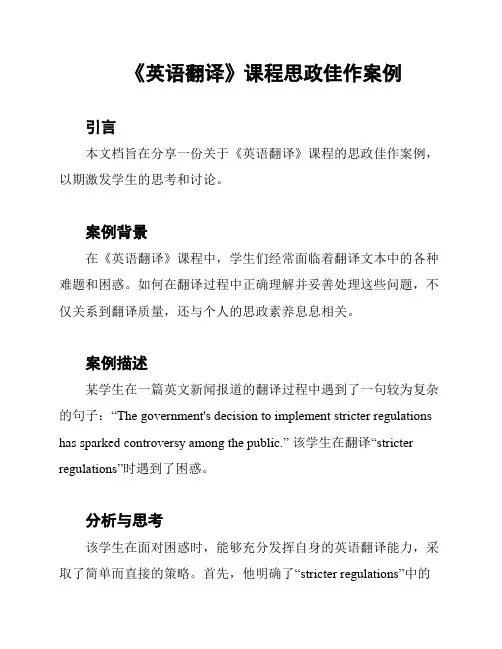
《英语翻译》课程思政佳作案例引言本文档旨在分享一份关于《英语翻译》课程的思政佳作案例,以期激发学生的思考和讨论。
案例背景在《英语翻译》课程中,学生们经常面临着翻译文本中的各种难题和困惑。
如何在翻译过程中正确理解并妥善处理这些问题,不仅关系到翻译质量,还与个人的思政素养息息相关。
案例描述某学生在一篇英文新闻报道的翻译过程中遇到了一句较为复杂的句子:“The government's decision to implement stricter regulations has sparked controversy among the public.” 该学生在翻译“stricter regulations”时遇到了困惑。
分析与思考该学生在面对困惑时,能够充分发挥自身的英语翻译能力,采取了简单而直接的策略。
首先,他明确了“stricter regulations”中的“regulations”指的是“法规”,通过对上下文的理解和结合词义的推测,他将其翻译为“更严格的法规”。
其次,他注意到“stricter”表示一种程度上的增强,于是选择了“更严格”的表达方式。
最后,他意识到“has sparked controversy among the public”是对政府决策的影响,因此将其翻译为“在公众中引发了争议”。
思政启示通过这个案例,我们可以看到学生在翻译过程中能够独立思考,遵循简单策略,避免了法律上的复杂性。
他对语境的理解和词义的推测能力也得到了充分展示。
在这个过程中,学生不仅仅是在进行英语翻译的技巧训练,更是在培养独立思考和判断能力。
这种能力对于学生的思政素养和综合素质的培养具有重要意义。
结论作为《英语翻译》课程的思政佳作案例,该学生在翻译过程中展现了独立思考和简单策略的优势。
他通过准确理解语境和推测词义,成功解决了翻译中的困惑。
这个案例提醒我们,在研究和实践中,我们应该注重培养学生的独立思考能力,引导他们在面对问题时采取简单且有效的策略,以取得更好的研究效果和综合素质的提升。
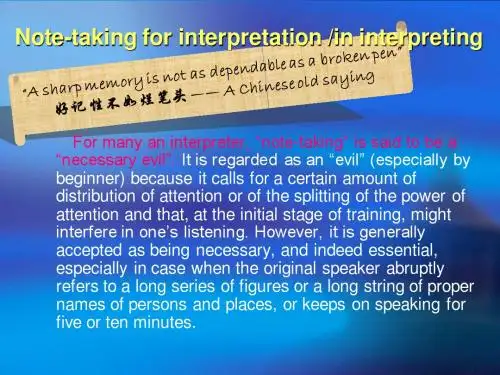
英语口译二级精讲班第8讲课件讲义英语口译二级精讲班第8讲课件讲义(环球职业教育在线)英语口译二级精讲班第8讲讲义主题练习(下)主题练习——教育在实施“科教兴国”和“人才强国”战略,全面建设小康社会的进程中,中国政府将推动教育事业持续健康协调快速发展,构建完善的国民教育体系和终身教育体系,培养数以亿计的高素质劳动者,数以千万计的专门人才和一大批拔尖创新人才,并促进教育与科技创新、经济建设、文化繁荣和社会进步的紧密结合。
//2003年12月30日,新一届国家科技教育领导小组召开第二次全体会议,听取了教育部关于制定《2003-2007年教育振兴行动计划》和《国家西部地区“两基”攻坚计划》的汇报1。
//《2003-2007年教育振兴行动计划》,明确了今后5年我国教育工作的方向、任务和目标,对教育改革和发展提出了具体要求。
《国家西部地区“两基”攻坚计划》,对实现西部地区基本普及九年义务教育、基本扫除青壮年文盲做出了具体部署。
//实施这两个计划,对于提高全民族的素质,对于经济和社会的全面、协调和可持续发展,具有重大意义2。
教育部将按照会议要求,从“科教兴国”、“人才强国”和推进西部大开发的战略高度,认真实施这两个计划。
//今后,中国教育将按照“巩固成果、深化改革、提高质量、持续发展”的方针,全面推进各级各类教育持续健康协调快速发展。
// ——重点推进农村教育的改革和发展。
中国70%的人口在农村,农村(含县镇)义务教育阶段学生高达1.6亿。
2004年,将实施国家西部地区“两基”攻坚计划,用五年的时间,在西部地区实现基本普及九年义务教育和基本扫除青壮年文盲的目标,让西部的孩子们都能上学,打赢西部地区“两基”攻坚战;//已经实现“普九”目标的地区特别是中西部地区,要巩固“两基”成果,全面提高普及九年义务教育和全面提高义务教育质量。
经济发达的农村地区要高水平、高质量“普九”。
同时,积极推进农村中小学现代远程教育工程,进一步健全完善“以县为主”的农村义务教育管理体制。
翻译二级口译实务-(暂无语音,提供参考)2(总分100,考试时间90分钟)Part ⅠInterpret the following passages from English into Chinese. Start interpreting at the signal and stop it at the signal. You may take notes while you are listening. You will hear the passage only once. Now let's begin.1. Passage 1I am delighted to be with you. I first visited China 22 years ago, but this is my first visit to your university, in a city whose students have helped shape the development of modem China. So I am privileged to have the opportunity to share ideas about U.S.-China relations in the modem era of globalization with people who will, I expect, help write Chinese history -- through deeds and words -- in the 21st century.//It was the students of Beijing who in May 1919 protested the Treaty of Versailles' failure to expel Japanese occupiers from China. In that action, the source of the May 4 Movement, Beijing's students not only made a bold statement about China's freedom from foreign occupation and right to self-determination. They also ushered in the era of modern China, taking a decisive step toward China's emergence from imperial rule and stagnation. I think it is useful to begin our exchanges about the future from the vantage point of what happened almost a century ago in this historic city.//Chinese are rightly proud of the history of the world's oldest continuous civilization, and look to it for lessons. America is a young nation by comparison, but suggestion that we live exclusively in the present, unshaped by history, is a misleading caricature. So I would like to share with you my perceptions about what this last century has meant to our two countries, how we have perceived each other, and where we are going. Many people talk about this new millennium as an unprecedented age of globalization. Extraordinary it is, but unprecedented it is not. // In 1902, the automobile was **ing into use in the United States. Man's first airplane flight occurred 99 years ago, on a beach in North Carolina. The wireless radio followed in a few years, transforming societies -- much like the Internet is doing today. The telephone enabled people to converse across mountains, rivers, and indeed around the world. The United States was transformed by this earlier era of globalization in the most fundamental way -- the face of its population. In each year of the first decade of the last century, new immigrants to America numbered about one percent of the existing population.//A country that had been **posed of people of English, German, Irish, and Africa descent found itself the chosen destination of millions of immigrants from different parts of the planet -- Poles, Russians, Italians, Chinese, Japanese, and Jews, among others. Their contributions to Americaneconomic, social, scientific, intellectual, and political life were enormous. We learned that openness -- to people, goods, capital, and of course ideas -- is our greatest strength as a country and society. Although change and adaptation and intrusions from outside can be frightening, and pose difficulties of adjustment, openness spurs dynamism, flexibility, competition, liberty, and the individual pursuits of happiness.//2. Passage 2My wife Nane and I are both extremely happy to be with you today. I feel truly proud to belong to this extraordinary class of 2004, and I am pleased to see that so many parents and family members were here today. The day belongs to them, too. Without their constant support, understanding and sacrifice, none of us could have achieved what we have. For me, to receive a degree from Harvard is a very great honor indeed. There are few countries in the world whose leaders in public life, business, science and the humanities have not had some association with Harvard -- and no country that has not benefited from Harvard's outstanding contributions to human knowledge.//You have invited me, I know, not as an individual, but as Secretary-General of the United Nations. You are saying that the United Nations matters, and that you want to hear what we have to say. Are you right in believing that the UN matters? I think you are, because the UN offers the best hope of a stable world and a broadly equitable world order, based on generally accepted roles. That statement has been much questioned in the past year. But recent events have reaffirmed, and even strengthened, its validity. A role-based system is in the interest of all countries --especially today. Globalization has shrunk the world. The very openness, which is such an important feature of today's most successful societies, makes deadly weapons relatively easy to obtain, and terrorists relatively difficult to restrain. //Today, the strong feel almost as vulnerable to the weak as the weak feel vulnerable to the strong. So it is in the interest of every country to have international rules and to abide by them. And such a system can only work if, in devising and applying the rules, the legitimate interests of all countries are accommodated, and decisions are reached collectively. That is the essence of multilateralism, and the founding principle of the United Nations. All great American leaders have understood this. That is one of the things that make this country such a unique world power. America feels the need to frame its policies, and exercise its leadership, not just in the light of its own particular interests, but also with an eye to international interests, and universal principles.// Among the finest examples of this was the plan for reconstructing Europe after World War Ⅱ, which General Marshall announced here at Harvard in 1947. That was one part of a larger-scale and truly statesmanlike effort, in which Americans joined with others to build a new international system -- a system which worked, by and large, and which survives, in its essentials, nearly 60 years later. During those 60 years, the United States and its partners developed the United Nations, built an open world economy, promoted human rights and decolonization, and supported the transformation of Europe into a democratic, **munity of states, such that war between them has become unthinkable.//Part ⅡInterpret the following passage from Chinese into English. Start interpreting at the signal and stop it at the signal. You may take notes while you are listening. You will hear the passage only once. Now let's begin.1. Passage 1首先,我感谢莱文校长的邀请,使我有机会来到世界著名学府耶鲁大学,同青年明友和老师们相聚在一起。
Teaching Manual An Intermediate Course of Interpretation For the Academic Year 2008-2009English MajorAn Overview of InterpretationI Introduction to the teaching scheduleII Preliminary Recognition to InterpretationIII Interpretation and the Interpreter3.1 The development of interpretation3.2 The definition of interpretation3.3 The characteristics of Interpretation3.4 The criteria of interpretation3.5 The Process of interpretation3.6 The Categorical classification of interpretation3.7 A tripartite model of interpretation3.8 Interpreter qualification requirements3.9 Interpreter Training3.10 Research in interpretation and interpreting3.11 Difficulties in interpretationGuiding LessonI Introduction to the teaching schedule•Eighteen weeks class study+ one week practical training.•Sixteen weeks finish sixteen units.•Two Weeks quizzes.•One week practical training.•Exam: Final result = 40% daily work + 60% final exam result.Daily work = 30% attendance + 40% performance + 30% quizzes results.Final exam result = 50% oral interpretation + 50% Exam paper.II Preliminary Recognition to the Interpretation1.As an English major student, have you ever thought about whatmain significance of foreign language learning is?To communicate with foreign culture, exchange the ideas withforeigners. Or in some sense, we can say ultimate significance of second language learning is translation. (Written translation and interpretation) So some scholar said interpretation/translation is not only the contact between two languages, but the collision/clash of two cultures.2.What is the language and what is the interpretation? Let’s learn itwith three exercises. After we finish these three exercises, we will draw a conclusion to answer the questions.Directions:Listen to the following two parts of remarks and then make retelling the main ideas respectively from Chinese to Chinese and from English to English. And interpreting the third part of words from English to Chinese firstly, and then interpreting it back to English. Taking notes is not permitted.A.Chinese to Chinese (retelling)闭幕式,我们要把掌声献给那些在赛场上拼搏了十多天的运动员们。
课程思政案例:InterpretingII(口译二)一、课程简介InterpretingII是口译进阶课程,面向英语专业修过口译I 并已掌握基础口译技能的大三、大四学生,属于专业选修课;多数学生出于喜欢口译、想进一步提高口译技能、有志于往口译专业深造或毕业后从事相关工作等而修读本课程。
本课程通过英-汉、汉-英综合口译训练、口译技能和专题知识讲解、观摩总理答中外记者问、模拟口译现场和模拟会议口译、新闻播报与评论等课堂活动,进一步提高学生的口译技能和时政敏感度、以及对口译职业道德规范与素养的认识。
与此同时,通过大量有关中国优秀传统文化和现代化建设发展、国际交流和经济合作等内容的汉-英口译练习,使学生不仅理解上述内容的深刻内涵,还掌握如何用英语进行表达和宣传。
二、课程内容三、教学组织过程(一)引入:介绍今天课程主要内容及其重要性和意义(3分钟)每年国家“两会”闭幕式之后的总理记者招待会被视为是口译学习的经典教材,国家外交部口译员用其“教科书般的”口译表现展示了国家顶级口译(连传)水平;同时,记者会现场涉及当前国家政治、民生最热门的话题,学生在欣赏译员高水平口译展示的同时,还可以了解国情民情、了解国家最新政策以及如何用双语表达这些热门话题和政策内容;在观摩记者会口译的同时,学生还能感受到总理以及总理所代表的党和政府是如何忧国忧民、为国为民。
(二)第一部分:观摩学习外交部口译员在口译现场的外部表现(包括形象着装、举止、声音表现等)并进行课堂讨论(20分钟)步骤一:播放事先剪辑的视频,视频内容为2007、2013以及2020三场总理答中外记者会开场部分,时长约8分钟;并引导学生重点观察译员的形象、举止、声音等外部表现;步骤二:课堂讨论,鼓励学生就所观察到的内容积极发言和讨论,也可提出疑问共同探讨,在这个过程中教师加入适当的必要的引导和总结,对学生进行口译员职业道德规范和专业素养的教育,如着装要求、举止规范和礼仪、声音控制和规范、不插话不抢译等。
(三)第二部分:口译实践+观摩对比,学习国家口译员的现场口译处理和双语表达(约40分钟)让学生观看事先剪辑的视频(案例3),视频内容为2020年总理答中外记者问的节选,并要求学生在观看视频的同时,先尝试自己进行口译实践(上一周课后已布置作业要求学生阅读学习《政府工作报告》的双语版本,并整理积累热点词汇和高频词句作为本周课堂内容的准备),然后再播放现场译员的口译,让学生进行对比和反思。
学生由于自己先尝试过口译,能更深入地了解该段发言当中的口译重点和难点,在这个基础上观摩专业译员的展示,通过对比自己的口译处理和专业译员的口译处理,从而更深入地体会并学习专业译员精湛的口译能力和文化功底。
具体操作步骤:播放记者提问——暂停——请学生尝试进行口译——播放译员的口译——播放总理的回答——暂停——请学生先尝试进行口译——播放口译员的口译——请学生进行对比、反思和总结。
继续播放记者提问——暂停——请学生尝试进行口译——播放译员的口译——播放总理的回答——暂停——请学生先尝试进行口译——播放口译员的口译部分——请学生进行对比、反思和总结。
……如此循环操作4-5轮(四)结尾:外交部各个时期口译员介绍和访谈内容(15分钟)经过上述视频的观摩和对比学习,学生已深刻认识到外交部译员高超的专业技能和职业规范,在这个基础上通过PPT形式向学生展示介绍新中国成立以来各个时期外交部口译员的风采,包括这些译员的学习、成长背景,以及他们分享有关外交部翻译工作的艰辛与荣耀,与今天课程的主要内容形成呼应,加深学生对外交部口译员以及口译工作的认识和了解,深化职业精神和职业理想教育。
(五)课后作业:除每周固定作业之外,继续观看剩余的2020总理答中外记者会视频(建议采用今天课堂的方式先尝试自己口译后再进行观摩对比)并完成以下两项任务:1.找出十处口译难点并分析译员是如何进行处理的;2.整理记录本次中外记者会提及的热点话题和高频词汇的中英文表达对照表,其中包含30个以上词汇或短语的双语表达+20个以上经典句型的双语表达。
以上作业用Word文档形式完成,并于下周上课之前通过Mystu平台分两个文档提交。
四、教学反思这一章节的内容既能向学生展示目前中国最高水准的(连传)口译技能,又能对学生进行职业道德规范和职业精神、职业理想教育。
而且通过口译现场视频观摩的方式进行教学,既真实又直观,学生可以很自然地理解各个知识点,也能潜移默化地得到思政教育。
但由于教学案例展示的是国家级口译员的专业表现,而且总理答中外记者问的材料内容难度较大,可能会给学生的自信心带来一定的打击。
因此,教师在授课时,要注意照顾学生这方面的情绪,明确告诉学生此次教学内容重点在于观摩欣赏,并不要求掌握相应能力。
外交部译员们也是需要经过千锤百炼才能有今天的表现,让大家进行观摩是希望大家将其树立为榜样,见贤思齐。
五、案例案例1:2007、2013和2020“两会”总理答中外记者提问开场部分视频剪辑(一)案例简介该视频是截取2007年、2013年和2020年总理答中外记者会现场视频的开场部分的合辑,其中包含2名男译员和1名女译员(2007年记者会是由费胜潮担任温家宝总理的译员,2013年是由孙宁担任李克强总理的译员,2020年是由张璐担任李克强总理的译员)。
视频内容是以上三场记者会各自的开场部分,从国家领导人和译员进入金色大厅开始到译员完成总理的开场发言口译为止。
(二)案例点评1.适用范围国家外交部译员代表着国家口译行业最高的水准和职业典范。
本案例展示了三名国家外交部口译员在形象、着装、行为举止、声音表达、以及和发言人之间的配合等外部表现,可以让学生同时观察和欣赏到(不同性别的)国家译员们的风采和专业展示。
之所以选取开场部分是因为记者会的拍摄焦点一般都是在主持人、总理和记者身上,很少有专门的镜头给译员,只有在进场这部分能够比较完整地看到译员的身影。
2.思政元素该视频形象直观地向学生展示了国家外交部译员在工作场合中的整体表现,包括形象、着装、行为举止、声音表现以及和发言人关系的处理等,具有口译职业规范和职业道德教育元素。
3.课程思政教学目标学生们通过观看视频观察学习到专业译员的职业规范和职业道德:着装规范——出席高规格的会议现场,男译员必须穿正装(西装加领带),女译员也必须职业套装;衣服色彩不宜鲜艳;形象规范——发型简洁干练,不宜过多装饰或影响视线和工作(如刘海遮眼或长发飘飘等);女译员宜化淡妆;举止规范——走姿大方干练、坐姿端正挺拔;礼仪规范——不抢镜、不喧宾夺主、保持低调;不得先于总理和其他领导人之前入座;声音规范——音量适中、发音标准、吐词清晰、语速适中、表达流畅、重点突出;职业道德——不插话、不抢译、不得喧宾夺主;于讲话人结束讲话后快速开始口译;4.相关教学经验教师在在播放该视频之前,要引导学生注意观察译员的哪些具体方面,如着装、走姿、入场方式、坐姿、声音表达等。
在播放时,要及时给学生指出画面中哪一位是译员,因为学生并不熟悉译员,不一定能在第一时间关注到译员。
但是当学生已经辨认出哪一位是译员之后,就不要干扰学生观看视频,让学生自己观察译员的表现。
等视频结束之后,要引导学生就所观察到的情况积极发言,可以分一个方面一个方面地进行讨论,如外形服装方面、行为举止方面、声音传达方面等,在学生发言之后教师要进行总结和提炼,强调译员这些方面职业规范。
教师进而提问学生是否留意到译员进场和入座时有什么特别的表现,引导学生回想起译员是如何避开镜头、保持低调、刻意等总理等领导人开始入座后再坐下等细节;并告诉学生这些既是译员的职业礼仪规范,也是职业道德,译员虽然在会场上发挥着重要作用,但却应该始终保持低调,保持谦逊,不得喧宾夺主。
最后,教师提问学生还观察到一些什么细节,由学生自由发言,教师适时回应和点评。
有学生提到视频当中译员有两次和总理同时开口说话的情况,也有学生反映总理的开场白信息太多太长了(在选择视频内容时刻意将这些片段选入视频当中),教师这时应向学生指出:一、由于温总理说话比较慢、停顿时间较长,译员有时会误判,以为总理是停下来让他翻译,但是一旦发现总理还要继续说话,译员马上让步,让总理继续说完;二、哪怕再长的发言,译员也应该认真、耐心地边听边记录——不插话、不抢译,这些都是译员的职业规范、更是职业道德。
所以平常就应该练好口译的记忆和笔记能力,接受任何长度信息的挑战。
案例2:2020年总理答中外记者问现场视频节选(一)案例简介2020年总理答中外记者问是由张璐为李克强总理进行现场口译,今年是张璐第十一次担任总理答中外记者会的译员,她的口译水平已得到业内和社会的一致认可,代表着中国(连传)口译的最高水准。
该视频选取了李克强总理此次中外记者会的5处经典回答,其中包含了很多成语、俗语等中国文化负载词,还有很多形象生动的比喻,这些对口译员来说都是挑战。
此外,这5处回答的内容包含了当前中国政治和民生最热点的问题以及国家相应的政策,如当前中国的经济形势和经济政策、抗疫特别国债、大学生就业等。
学生在学习张璐的口译技巧的同时,还能了解到当前国内的热点问题和国家政策,以及如何对之进行双语表达。
(二)案例点评1.适用范围每年国家“两会”结束后的总理答记者招待会被视为是口译学习的经典教材,国家外交部口译员用其“教科书般的”口译表现向我们展示了国家顶级的口译(连传)水平;同时,记者会现场涉及了当今国家政治、民生最热门的话题,学生在欣赏译员高水平口译展示的同时,还可以了解国情民情、了解最新政策以及如何用双语表达这些热门话题和政策内容;在观摩记者会口译的同时,学生还能感受到总理以及总理所代表的党和政府是如何忧国忧民、为国为民。
因此,2020年总理记者招待会无疑是口译学习者学习口译技能、观摩职业译员的专业展示、了解最新时事政治和国家政策的最佳学习材料。
该案例所选取的5处总理的回答当中,包含了很多成语、俗语等中国文化负载词,还有很多形象生动的比喻,比如总理在回答路透社记者关于(疫情冲击下)中方是否会出台更大规模的刺激(经济)政策时说道:“过去我们说不搞大水漫灌,现在还是这样,但是特殊时期要有特殊政策,我们叫作“放水养鱼”。
没有足够的水,鱼是活不了的。
但是如果泛滥了,就会形成泡沫,就会有人从中套利,鱼也养不成,还会有人浑水摸鱼。
所以我们采取的措施要有针对性,也就是说要摸准脉、下准药。
钱从哪里来、用到哪里去,都要走新路。
”张璐对类似这样的表达进行了巧妙到位的口译处理和英文传达,展现出深厚的中国文化功底和对时事政策的深度把握,值得学生学习和借鉴。
学生在学习如何翻译这段话的过程中,还了解到国家目前经济政策上的总体方针是什么,总理等决策者是如何做全面考量的,用中文和用英文应该怎么对之进行表述,等等。